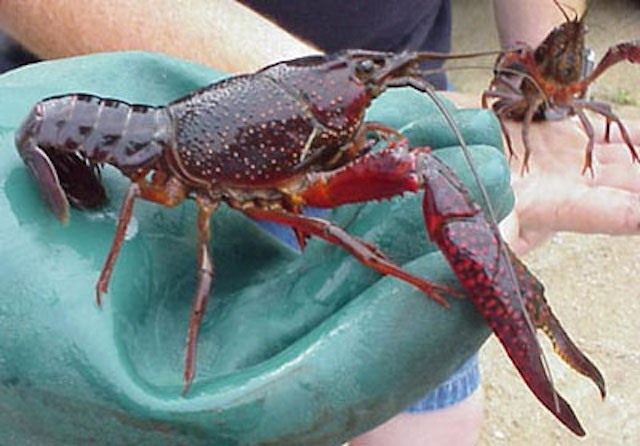 Society
Society

Authorities in the Cửu Long (Mekong) Delta province of Đồng Tháp will continue to closely monitor the illegal breeding of crawfish, which has caused serious damage to crops in the area.
 |
| Crawfish, an invasive species banned in Việt Nam, can cause serious damage to crops and disease in shrimp. — Photo 24h.com.vn |
HCM CITY — Authorities in the Cửu Long (Mekong) Delta province of Đồng Tháp will continue to closely monitor the illegal breeding of crawfish, which has caused serious damage to crops in the area.
Considered an exotic invasive species in Việt Nam, crawfish are banned from import by the Ministry of Agriculture and Rural Development’s Aquaculture General Office.
Authorities learned about the crawfish breeding after local residents reported seeing them in a pond on a farmer’s field in Tân Hội Trung Commune in Cao Lãnh District.
A local company had rented land from the farmer to cultivate lotus plants in ponds, according to local authorities.
Nguyễn Tấn Xiếu, head of the main office of the province’s People’s Committee, said the provincial Aquaculture Division and other agencies had destroyed around 107 crawfish in the pond and sprayed pesticides in an attempt to wipe out all the crawfish in the area.
However, some of the crawfish could still be living in the bottom of ponds, he said.
Most crawfish in Việt Nam are imported illegally from China, according to the Pháp Luật TPHCM (HCM City Law) newspaper.
Last year, Trần Văn Hòa, director of Sen Hoàng Giang Ltd Co, rented 2,500sq.m of land from farmer Đinh Văn Út in Tân Hội Trung Commune to cultivate lotus plants.
The company hired Út in April last year to cultivate lotus after receiving training from Chinese workers employed by Hòa’s company.
The imported lotus plants, which are different from local lotus flowers in that they do not flower, were cultivated for their rootstocks only.
Hòa’s company rented the land for three years to plant lotus to use the rootstocks for export, according to the province’s Department of Agriculture and Rural Development.
The land lot, located on Út’s 22-ha rice field, was being rented for VNĐ3.5 million (US$154) per 1,000sq.m per year, according to the department.
The department allowed the company to plant lotus on 3,000sq.m on a trial basis in a more isolated area used for lotus cultivation.
The province’s Aquaculture Division inspected the site twice and confirmed that crawfish were being raised by Hòa.
Hòa told local authorities that he had been raising four kilos of crawfish (about 120 crawfish) in a 500-sq.m pond on the rented land lot.
He said that he did not know that it was considered a harmful species in Việt Nam, and that he had received the crawfish from a friend of his, whose name he did not reveal, according to local authorities.
Út, who had been hired by Hòa, said all of the lotus plants had been destroyed by the crawfish.
Phạm Minh Chí, deputy manager in charge of legal issues of the province’s Aquaculture Division, said “This is considered an invasive, exotic species in Việt Nam which can cause damage to crops, so the division has worked with Hòa to destroy them all.”
“We have also asked him to spray pesticide to kill all the crawfish in the pond so there would be no risk of spread to other locations,” he added.
Nguyễn Thành Tài, deputy director of the province’s Department of Agriculture and Rural Development, said on February 5 that the department’s inspection team visited the site and noticed that Hoà and his Chinese employees were not present at the time.
He said all of the cultivated lotus had died and the crawfish had been destroyed by the Aquaculture Division.
Nguyễn Văn Dương, chairman of the province’s People’s Committee, said local agencies would monitor the situation and continue to destroy any remaining crawfish.
Crawfish, also known as crayfish, crawdads, freshwater lobsters, mountain lobsters, mudbugs or yabbies, are freshwater crustaceans resembling small lobsters, to which they are related.
They breathe through feather-like gills. Some species are found in brooks and streams where there is running fresh water, while others thrive in swamps, ditches and rice paddies.
Most crawfish cannot tolerate polluted water. They feed on living and dead animals and plants.
The species, common in Louisiana in the US, is often called Louisiana crayfish. — VNS




